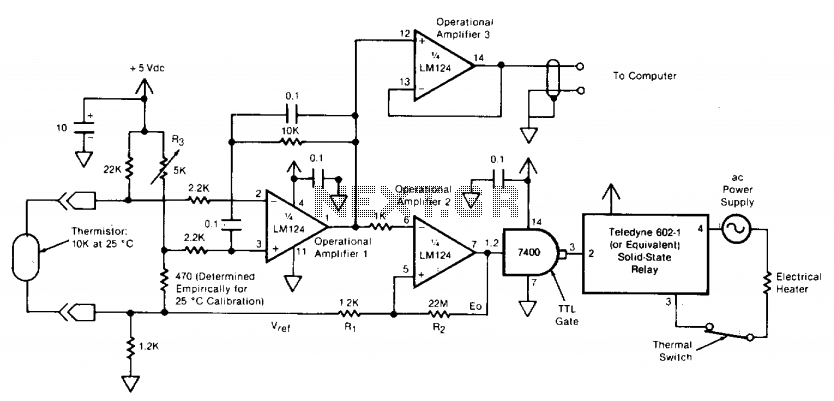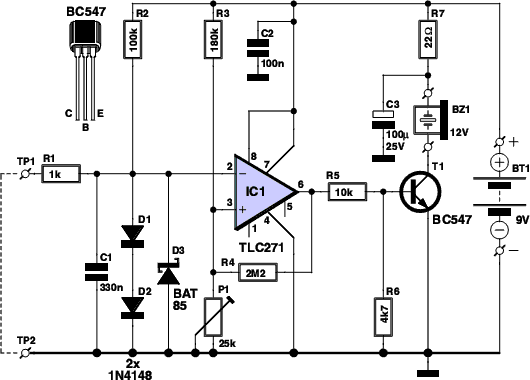
thermometer circuit

When the system is placed in a shop or mall, logos and product advertisements serve as an ideal complement to temperature information. For home use, photographs of children at the beach or, should the temperature drop, images of making a snowman are thoughtful gifts for grandparents. Other application areas include hotels, airports, sports resorts, and tourist sites. Despite its rich feature set, the DVD thermometer boasts an impressively simple design that requires very few components, thanks to an ingenious mechanism. It is significantly less expensive than typical PC-centric solutions. The circuit operates on battery power and fits comfortably into a small plastic enclosure, positioned in front of a standard DVD player. A switch and an infrared LED are visible on the box. The DVD player is loaded with a disc pre-recorded with images corresponding to various temperatures in a well-known sequence. Functioning as an intelligent infrared remote control, the DVD thermometer directs the player to select the scene that matches the ambient temperature. The DVD thermometer was constructed at home using basic tools, including a soldering iron, a multimeter, a personal computer with a standard CD-R burner, and a Motorola QT demo board. It was entered into the "Flash Innovations" Design Contest sponsored by Motorola, where it won the "Distinctive Excellence Prize." The circuit diagram is remarkably simple, comprising a low-cost 8-pin microcontroller, a digital temperature sensor, and an infrared LED. The complexity is managed through software, which is a crucial element of the project. The program was written in C, emphasizing low-power techniques, code reuse, portability, and data encapsulation. Consequently, all modules are contained within separate files, allowing for easy adaptation to other applications with minimal changes. Even if temperature measurement is not the primary interest, the fundamental techniques can be repurposed for displaying various types of data. This project can yield valuable reusable software modules, including a specialized digital temperature sensor integrated circuit that measures ambient temperature and converts it into a digital word readable by the microcontroller via the I2C bus. Since the microcontroller lacks hardware I2C support, the I2C driver is implemented in software, forming the basis for the thermometer chip driver required by the main application firmware. Another software module enables the microcontroller's internal 16-bit timer to function as a programmable pulse generator (PPG). These pulses are processed by the RECS-80 remote-control encoder block to drive the infrared LED connected to a port pin. The SLEEP manager module ensures that all previous blocks are activated in a timely manner, preventing power wastage during idle periods. The DVD player uses a specially recorded disc that sequences images, each representing a different temperature value. When played normally, the disc displays all temperatures within the thermometer's range, from the lowest to the highest. If the displayed temperature deviates from the ambient temperature, it instructs the DVD driver to change the image on the TV. The DVD driver utilizes the RECS-80 embedded remote control to guide the DVD player to the correct position. The DVD player cannot distinguish between a genuine remote control and the infrared signals received from the circuit. This adjustment process continues until the temperature displayed on the TV aligns with the ambient temperature. Due to the lack of feedback from the DVD player regarding the current image being displayed, both the microcontroller and the player must commence from a known temperature/image pair. To ensure that the DVD player always starts from the first image in the sequence, the microcontroller halts and restarts the disc during the initialization phase.
The schematic for the DVD thermometer consists of the following key components: an 8-pin microcontroller (such as an ATtiny series), a digital temperature sensor (like the LM75 or similar), an infrared LED (typically operating at 940 nm), and passive components including resistors and capacitors for stabilization and current limiting. The microcontroller is programmed to read the temperature data from the sensor over the I2C bus, which is implemented in software due to the microcontroller's lack of native I2C hardware support.
The infrared LED is driven by a GPIO pin configured as a pulse generator, sending modulated signals to the RECS-80 encoder, which formats the signals for compatibility with the DVD player's infrared receiver. The SLEEP manager module ensures power efficiency by putting the microcontroller into low-power modes between readings and transmissions.
The temperature sensor outputs a digital value that the microcontroller interprets to determine the corresponding image to be displayed. The DVD player, upon receiving the signal from the microcontroller, adjusts the displayed image accordingly. The system's design allows for flexibility and adaptability, making it suitable for various applications beyond temperature display, including any data visualization tasks. The modular software architecture enables easy updates and enhancements, ensuring that the design remains relevant and functional for future uses.When the system is placed in a shop or mall, logos and product advertisements are a perfect complement to temperature information. For home use, photos of the kids at the beach or should the temperature drop- in the making of Mr. Snowman are a nice gift for Grandma. Other application areas include hotels, airports, sport resorts, and tourist si tes. Despite of its rich feature set, the DVD-thermometer is an amazingly simple design that requires very few components thanks to an ingenious mechanism. And it is hundreds of dollars cheaper than the typical PC-centric solution. The circuit is battery operated, and fits comfortably a small plastic box, located in front of an ordinary DVD-player.
A switch and an infrared LED peep out of the box. The DVD-player is loaded with a disk, pre-recorded with all of the pictures corresponding to different temperatures, in a well-known order. Acting as an intelligent infrared remote control, the DVD-thermometer directs the player, selecting the scene that matches ambient temperature.
I made the DVD-thermometer at home, for the fun of doing it, with no special tools other than a soldering iron, a multimeter, a PC with ordinary CD-R burner, and the Motorola QT demo board. I submitted it to the "Flash Innovations" Design Contest sponsored by Motorola, and it won the "Distinctive Excellence Prize".
The circuit diagram is embarrassing simple: it is entirely built around a cheap 8-pin microcontroller, a digital temperature sensor and an infrared LED. The hard work is delegated to the software, which is the most important ingredient of the project. I wrote the program in C, implementing low-power techniques, with code reuse, portability and data encapsulation in mind.
As a result, all of the modules reside in separated files, ready to be ported to other applications changing only a few #define. Even if you are not interested in taking temperatures, the basic techniques can be adapted for displaying any sort of data.
They are worth to be added to your bag of tricks, just in case. Along the way, you can collect some very valuable, very reusable software modules, like: A specialized digital temperature sensor IC measures ambient temperature, and converts it in a digital word that can be read by the microcontroller via the I2C bus. The microcontroller does not have an hardware I2C, therefore the I2C driver is implemented in software.
This driver works as the foundation for the thermometer chip driver, which in turn is required by the main application firmware. Another software module makes microcontroller`s internal 16-bit timer to work as a programmable pulse generator (PPG).
These pulses are assembled by the RECS-80 remote-control encoder block, in order to drive an infrared LED connected to a port pin. The SLEEP manager module ensures that all the previous blocks are called in a timely manner and no power is wasted in between.
The DVD player is loaded with a special disc, recorded in advance with a sequence of pictures, each showing a different temperature value. If played normally, the disc would show all the temperatures in the thermometer range, from the lowest to the highest.
If it differs from the on-screen temperature, it instructs the DVD driver to change the TV picture. The DVD driver uses the RECS-80 embedded remote control to direct the DVD player to the appropriate position. The DVD player cannot tell between a real remote control and the infrared stream it receives from the circuit.
The adjustment is repeated until the temperature seen on TV matches again ambient temperature. As there is no feedback from the DVD player telling the MCU which image it is playing, the microcontroller and the player must start from a well known temperature/picture pair. To ensure that the DVD player will always start from the first picture in the sequence, the microcontroller stops and restarts the disc during startup.
I started the design process r 🔗 External reference
The schematic for the DVD thermometer consists of the following key components: an 8-pin microcontroller (such as an ATtiny series), a digital temperature sensor (like the LM75 or similar), an infrared LED (typically operating at 940 nm), and passive components including resistors and capacitors for stabilization and current limiting. The microcontroller is programmed to read the temperature data from the sensor over the I2C bus, which is implemented in software due to the microcontroller's lack of native I2C hardware support.
The infrared LED is driven by a GPIO pin configured as a pulse generator, sending modulated signals to the RECS-80 encoder, which formats the signals for compatibility with the DVD player's infrared receiver. The SLEEP manager module ensures power efficiency by putting the microcontroller into low-power modes between readings and transmissions.
The temperature sensor outputs a digital value that the microcontroller interprets to determine the corresponding image to be displayed. The DVD player, upon receiving the signal from the microcontroller, adjusts the displayed image accordingly. The system's design allows for flexibility and adaptability, making it suitable for various applications beyond temperature display, including any data visualization tasks. The modular software architecture enables easy updates and enhancements, ensuring that the design remains relevant and functional for future uses.When the system is placed in a shop or mall, logos and product advertisements are a perfect complement to temperature information. For home use, photos of the kids at the beach or should the temperature drop- in the making of Mr. Snowman are a nice gift for Grandma. Other application areas include hotels, airports, sport resorts, and tourist si tes. Despite of its rich feature set, the DVD-thermometer is an amazingly simple design that requires very few components thanks to an ingenious mechanism. And it is hundreds of dollars cheaper than the typical PC-centric solution. The circuit is battery operated, and fits comfortably a small plastic box, located in front of an ordinary DVD-player.
A switch and an infrared LED peep out of the box. The DVD-player is loaded with a disk, pre-recorded with all of the pictures corresponding to different temperatures, in a well-known order. Acting as an intelligent infrared remote control, the DVD-thermometer directs the player, selecting the scene that matches ambient temperature.
I made the DVD-thermometer at home, for the fun of doing it, with no special tools other than a soldering iron, a multimeter, a PC with ordinary CD-R burner, and the Motorola QT demo board. I submitted it to the "Flash Innovations" Design Contest sponsored by Motorola, and it won the "Distinctive Excellence Prize".
The circuit diagram is embarrassing simple: it is entirely built around a cheap 8-pin microcontroller, a digital temperature sensor and an infrared LED. The hard work is delegated to the software, which is the most important ingredient of the project. I wrote the program in C, implementing low-power techniques, with code reuse, portability and data encapsulation in mind.
As a result, all of the modules reside in separated files, ready to be ported to other applications changing only a few #define. Even if you are not interested in taking temperatures, the basic techniques can be adapted for displaying any sort of data.
They are worth to be added to your bag of tricks, just in case. Along the way, you can collect some very valuable, very reusable software modules, like: A specialized digital temperature sensor IC measures ambient temperature, and converts it in a digital word that can be read by the microcontroller via the I2C bus. The microcontroller does not have an hardware I2C, therefore the I2C driver is implemented in software.
This driver works as the foundation for the thermometer chip driver, which in turn is required by the main application firmware. Another software module makes microcontroller`s internal 16-bit timer to work as a programmable pulse generator (PPG).
These pulses are assembled by the RECS-80 remote-control encoder block, in order to drive an infrared LED connected to a port pin. The SLEEP manager module ensures that all the previous blocks are called in a timely manner and no power is wasted in between.
The DVD player is loaded with a special disc, recorded in advance with a sequence of pictures, each showing a different temperature value. If played normally, the disc would show all the temperatures in the thermometer range, from the lowest to the highest.
If it differs from the on-screen temperature, it instructs the DVD driver to change the TV picture. The DVD driver uses the RECS-80 embedded remote control to direct the DVD player to the appropriate position. The DVD player cannot tell between a real remote control and the infrared stream it receives from the circuit.
The adjustment is repeated until the temperature seen on TV matches again ambient temperature. As there is no feedback from the DVD player telling the MCU which image it is playing, the microcontroller and the player must start from a well known temperature/picture pair. To ensure that the DVD player will always start from the first picture in the sequence, the microcontroller stops and restarts the disc during startup.
I started the design process r 🔗 External reference





